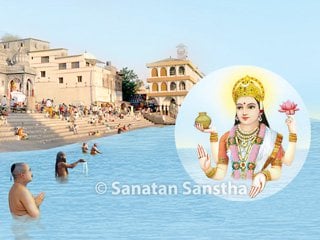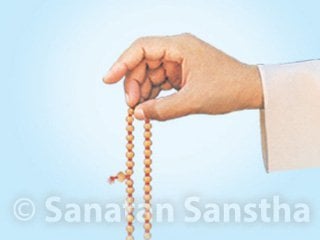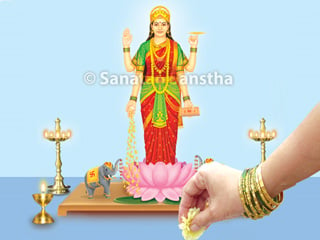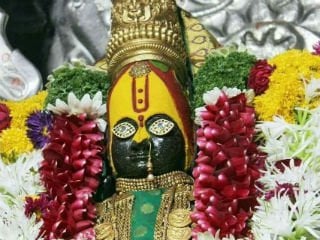In Navaratri, according to one school of thought, tama-predominant Shri Mahakali devi is worshipped on the first 3 days to reduce Tama component in ourselves. The next 3 days, worship the Raja-predominant Shri Mahalakshmi devi to enhance sattva component in ourselves. And on the last 3 days of Navaratri, worship sattva-predominant Mahasaraswati to intensify spiritual practice. Let us learn about AdiShakti, who is comprised of all these 3 shaktis.

‘Shakti’ (Divine Energy) is the attribute inherent in every object, which is necessary for its functioning and which does not exist independent of it.
There are two main forms of Deity Shiva. His first form is all-pervasive, pure, knowledgeable, blissful, full of Chaitanya (Divine consciousness) and absolute; in other words, it is the perpetually stable Parabrahman (Supreme God). His second form is Shaktitattva (Divine Energy Principle), which is always functioning in the universe. This Principle manifests itself through all the animate and inanimate objects in nature. The origin of Shakti is in the form of vibrations. Shakti is not separate from Deity Shiva but is a part of Deity Shiva. Shakti’s function is to activate Shiva who is in an inactive state. Creation, Sustenance and Dissolution are the attributes of Shakti. The cycle of Creation, Sustenance and Dissolution is unending.
The Shakti present in every Devata (Male Deity) was bestowed with divinity and that Shakti form was then referred to as Devi (Female Deity) or Shakti. Followers of the Shakta sect (Worshippers of Shakti) honoured Her as Adimaya (Primal Energy) or Jagadamba (Mother of the universe). Ordinary people too, view Shakti as a mother. Jagadamba is associated with all Deities including Brahma, Vishnu & Mahesh.
1. Meaning of Adishakti (The Primal Energy)
Mahakali represents the ‘Time’ Principle, Mahasaraswati the ‘Motion’ Principle and Mahalakshmi the Principle of ‘Direction’. All objects are destroyed with the passage of time. Where there is no motion, the process of Creation comes to a standstill. Despite this, a particular Shakti perpetually remains active for the creation, nurture, sustenance and multiplication of the universe within the eight directions. She is referred to as the Adishakti. The three Principles mentioned previously are inherent in this great Shakti.
‘Mahakali is tamasik (Tama-predominant); hence, the Tama component is attracted to Her picture. Mahakali is described as the one who resides in a cemetery. If there is a cemetery in the neighbourhood, the cemetery’s energy gets attracted to Her picture. Normally, the picture of a Devi with ten hands is not kept in the house; only that with four hands is kept.’ – 108 Mahant Swami Shri Prakashanandgiri (Khandeshwari Maharaj)
2. Some other Names
They are Adishakti, Parashakti, Mahamaya,Kali, Tripurasundari and Tripura. Specific information on some of them is given ahead.
A. Kali
As per Mahanirvan-Tantra, Kali (Adyashakti) is actually devoid of a form; but Her form is thought of in accordance with the characteristics and actions. When She is engrossed in Creation of the universe, She is Raja-predominant and red complexioned; during its Sustenance, She is Sattva-predominantand is fair complexioned and at the time of Dissolution of the universe, She is Tama-predominant and has a dark complexion.
B. Tripura
This is a form of Devi. The word ‘Tripura’ is defined in the Holy text Shabdakalpadrum as – the one who helps accomplish the three Purusharthas (Basic pursuits of life) of Dharma (Righteousness), Artha (Wealth) and Kama (Desire) is Tripura. Tripura has several forms, all of which were worshipped in the ancient times. Tripura manifested first as a virgin girl and later separated Herself into three forms as Tripurabala, Tripurabhairaviand Tripurasundari.
C. Tripurasundari
Followers of the Shakta sect refer to Tripurasundari as ‘Parashakti (Supreme Energy)’. Devotees worship her in the form of the moon. The moon has sixteen phases of which the first fifteen wax and wane but the sixteenth is constant. This sixteenth phase is referred to as the ‘eternal sixteenth phase’. This phase is the highest seat of beauty and Anand (Bliss) and is itself ‘Mahatripurasundari’
3. The three main forms of Adyashakti
Various forms assumed by Adyashakti according to the mission and the special features of each form are given in the table ahead.
| Name | Main component | Complexion | Associated Deity | Demons slain |
| Mahakali | Tama | Dark | Rudra-shiva | Madhu and Kaitabh |
| Mahalakshmi | Sattva | Fair | Shrivishnu | Mahishasur |
| Mahasaraswati | Raja | Red | Brahma | Shumbha-Nishumbha |

 Ganga – Shakti in the form of rivers
Ganga – Shakti in the form of rivers Why do we chant Name of Kuladevi instead of Kuladev?
Why do we chant Name of Kuladevi instead of Kuladev? What are the different types of Shaktis?
What are the different types of Shaktis? Shri Lakshmi – Deity of opulence
Shri Lakshmi – Deity of opulence Ritualistic worship of Devis
Ritualistic worship of Devis
Great article and unknown facts to Sri Adimaya, Jagadambaa.